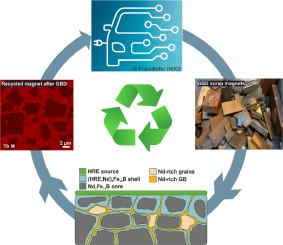当前位置:
X-MOL 学术
›
Acta Mater.
›
论文详情
Our official English website, www.x-mol.net, welcomes your
feedback! (Note: you will need to create a separate account there.)
Functional recycling of grain boundary diffusion processed Nd-Fe-B sintered magnets
Acta Materialia ( IF 8.3 ) Pub Date : 2024-11-08 , DOI: 10.1016/j.actamat.2024.120532 Mario Schönfeldt, Jürgen Rossa, Konrad Opelt, Kilian Schäfer, Lukas Schäfer, Fernando Maccari, Matic Jovičević-Klug, Tim M. Schwarz, Chi-Chia Lin, Mahmudul Hasan, Jürgen Gassmann, Dierk Raabe, Oliver Gutfleisch
Acta Materialia ( IF 8.3 ) Pub Date : 2024-11-08 , DOI: 10.1016/j.actamat.2024.120532 Mario Schönfeldt, Jürgen Rossa, Konrad Opelt, Kilian Schäfer, Lukas Schäfer, Fernando Maccari, Matic Jovičević-Klug, Tim M. Schwarz, Chi-Chia Lin, Mahmudul Hasan, Jürgen Gassmann, Dierk Raabe, Oliver Gutfleisch

|
Sintered Nd-Fe-B magnets industrially produced employing the grain boundary diffusion process (GBD) were recycled by the so-called functional or short-loop recycling approach, based on hydrogen decrepitation (HD). Microstructural and magnetic differences between the original and the recycled materials were analyzed. The functional recycling of GBD magnets leads to the dissolution of the core (heavy rare earth lean) - shell (heavy rare earth rich) structure through the different heat treatment steps which include hydrogen decrepitation, sintering, and annealing. The recycled magnets show similar rectangular demagnetization curves with squareness of 96 %, and only a slightly decreased remanence of 5 % to 1.31 T, but a larger decrease in coercivity of 21 % to 1703 kA/m. A new GBD step using 1.5 wt.% Tb with a pure Tb-foil as diffusion source leads again to the formation of a core-shell structure with 0.5 µm thick Tb-shells which is similar to the microstructure of the original magnets prior to recycling. The coercivity of the recycled magnets is increased by 35 % from 1315 kA/m to 1780 kA/m at 50 °C and shows similar magnetic values as the original industrial magnets at 150 °C and 200 °C, respectively. The temperature coefficients for the remanence, α, and for the coercivity, β, can also be fully restored and even exceed the original values which leads to an improved temperature stability of the recycled magnets compared to the original magnets.
中文翻译:

晶界扩散加工的 Nd-Fe-B 烧结磁体的功能回收
采用晶界扩散工艺 (GBD) 工业生产的烧结 Nd-Fe-B 磁体通过基于氢衰减 (HD) 的功能性或短环回收方法进行回收。分析了原始材料和回收材料之间的微观结构和磁性差异。GBD 磁体的功能回收导致核心(重稀土稀薄)- 壳(重稀土)结构通过不同的热处理步骤(包括氢分解、烧结和退火)溶解。回收磁体显示出类似的矩形退磁曲线,垂直度为 96%,剩磁仅略微降低 5% 至 1.31 T,但矫顽力下降幅度较大,为 21% 至 1703 kA/m。使用 1.5 wt.% Tb 和纯 Tb 箔作为扩散源的新 GBD 步骤再次导致形成具有 0.5 μm 厚 Tb 壳的核壳结构,这与回收前原始磁体的微观结构相似。在 50 °C 时,回收磁体的矫顽力从 1315 kA/m 增加到 1780 kA/m,增加了 35%,在 150 °C 和 200 °C 时分别显示出与原始工业磁体相似的磁值。剩磁 (α) 和矫顽力 (β) 的温度系数也可以完全恢复,甚至超过原始值,因此与原始磁体相比,回收磁体的温度稳定性更高。
更新日期:2024-11-08
中文翻译:

晶界扩散加工的 Nd-Fe-B 烧结磁体的功能回收
采用晶界扩散工艺 (GBD) 工业生产的烧结 Nd-Fe-B 磁体通过基于氢衰减 (HD) 的功能性或短环回收方法进行回收。分析了原始材料和回收材料之间的微观结构和磁性差异。GBD 磁体的功能回收导致核心(重稀土稀薄)- 壳(重稀土)结构通过不同的热处理步骤(包括氢分解、烧结和退火)溶解。回收磁体显示出类似的矩形退磁曲线,垂直度为 96%,剩磁仅略微降低 5% 至 1.31 T,但矫顽力下降幅度较大,为 21% 至 1703 kA/m。使用 1.5 wt.% Tb 和纯 Tb 箔作为扩散源的新 GBD 步骤再次导致形成具有 0.5 μm 厚 Tb 壳的核壳结构,这与回收前原始磁体的微观结构相似。在 50 °C 时,回收磁体的矫顽力从 1315 kA/m 增加到 1780 kA/m,增加了 35%,在 150 °C 和 200 °C 时分别显示出与原始工业磁体相似的磁值。剩磁 (α) 和矫顽力 (β) 的温度系数也可以完全恢复,甚至超过原始值,因此与原始磁体相比,回收磁体的温度稳定性更高。


















































 京公网安备 11010802027423号
京公网安备 11010802027423号